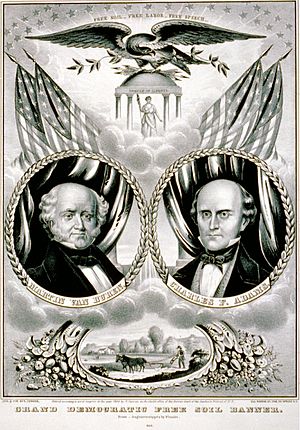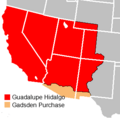Free Soil Party facts for kids
The Free Soil Party was a political group in the United States. It was active for a short time, mainly during the 1848 and 1852 presidential elections. This party was a "third party," meaning it wasn't one of the two main parties at the time.
The Free Soil Party was strongest in New York State. Its leaders were people who used to be in the Whig Party or the Democratic Party. They all shared one main goal: to stop slavery from spreading into new western lands.
They believed that a system with free people working on free land was better. It was better both morally and for the economy. They also worked to change laws that treated freed African Americans unfairly in states like Ohio. Most members of the Free Soil Party later joined the Republican Party in 1854.
Contents
What They Believed In
The Free Soil Party had a clear message. Their main slogan was: "Free Soil, Free Speech, Free Labor and Free Men." They promised to fight for these ideas until they won.
The party also wanted a law called a homestead act. This law would give free land to settlers in the West. They also supported a tariff, which is a tax on imported goods, but only to raise money for the government.
Most of their support came from parts of New York, western Massachusetts, and Ohio. The Free Soil Party thought that slavery hurt the idea of honest work. They believed it stopped people from moving up in society. This made slavery seem against democratic values. They saw slavery as an old-fashioned system that wasn't good for the economy. They believed if slavery was kept only where it already existed, it would eventually disappear.
Party History
In 1847, a big meeting of the Democratic Party in New York happened. They did not support the Wilmot Proviso. This was a plan to ban slavery in any land the U.S. gained from the Mexican War. Many members, called "Barnburners," walked out of the meeting.
Lewis Cass, who ran for president for the Democrats in 1848, believed in "popular sovereignty." This meant people in each new territory would vote on whether to allow slavery. The New York Democrats did not like this idea.
So, they joined with anti-slavery Whigs and most of the Liberty Party. Together, they formed the Free Soil Party in the summer of 1848. They held meetings in Utica and Buffalo, New York.
At these meetings, they chose former Democratic President Martin Van Buren to run for president. They picked Charles Francis Adams as his vice president. Important leaders of the party were Salmon P. Chase from Ohio and John P. Hale from New Hampshire.
In the 1848 election, the Free Soil candidates won 10% of the votes. However, they did not win any electoral votes. Many anti-slavery Whigs did not support Van Buren, which hurt the party's chances.
The party did not focus much on ending slavery everywhere. Instead, they stressed how slavery would harm free white workers and northern businesses in the new western lands. Some people, like William Lloyd Garrison, criticized this approach. But it appealed to many people who were against slavery but not extreme abolitionists.
The Compromise of 1850 was a set of laws that tried to settle the slavery issue for a while. This made the Free Soil Party's strong anti-slavery stance less urgent. Many "Barnburners" went back to the Democratic Party. The Free Soil Party then became led by stronger anti-slavery voices.
The party ran John P. Hale in the 1852 presidential election. But their share of the votes dropped to less than 5%. Two years later, a new law called the Kansas–Nebraska Act caused a lot of anger. After this, the remaining Free Soil Party members helped create the Republican Party.
Their Impact
The Free Soil Party was an important "third party." It was more successful than many others. They sent two Senators and fourteen Representatives to Congress between 1849 and 1851.
Their presidential candidate in 1848, Martin Van Buren, got many votes. He received 291,616 votes, but no electoral votes. Some historians believe the Free Soil Party's votes might have helped Zachary Taylor win the election. This is called a "spoiler" effect.
The party's real strength was in Congress. Their sixteen elected officials had a much bigger influence than their small numbers suggested. The most important thing the Free Soil Party did was provide a way for anti-slavery Democrats to join the new Republican Party.
In Ottawa, Illinois, in 1854, the Free Soil Party and the Whigs formed an alliance. This alliance, helped by a local newspaper publisher, led to the creation of the Republican Party.
Presidential Candidates
| Year | Presidential Candidate | Vice Presidential Candidate | Result |
|---|---|---|---|
| 1848 | Martin Van Buren | Charles Francis Adams | Lost |
| 1852 | John P. Hale | George W. Julian | Lost |
Other Important Free Soilers
- Charles Francis Adams, Sr., who ran for Vice President in 1848.
- Salmon P. Chase from Ohio, a key leader of the party.
- Joshua Reed Giddings from Ohio, a U.S. Congressman.
- Horace Mann, a famous educator.
- Charles Sumner from Massachusetts, a U.S. Senator.
- Walt Whitman, a famous poet.
- John Greenleaf Whittier, another well-known poet.
- Henry Wilson, who later became Vice President of the United States.
Images for kids
-
James G. Birney was a presidential candidate for the Liberty Party, which was similar to the Free Soil Party.
-
Free Soilers wanted to keep slavery out of the Mexican Cession (red area). This land was gained from Mexico in the 1848 Treaty of Guadalupe Hidalgo.
-
The party chose former President Martin Van Buren to run for president in 1848.
-
Salmon P. Chase from Ohio was one of the most important leaders of the Free Soil Party.
-
After the Kansas–Nebraska Act in 1854, Free Soilers joined with others to form the Republican Party.
-
Frederick Douglass was the secretary of the Free Soil National Convention in 1852.
See also
 In Spanish: Partido del Suelo Libre para niños
In Spanish: Partido del Suelo Libre para niños










